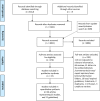Intermittent auscultation fetal monitoring during labour: A systematic scoping review to identify methods, effects, and accuracy
- PMID: 31291375
- PMCID: PMC6619817
- DOI: 10.1371/journal.pone.0219573
Intermittent auscultation fetal monitoring during labour: A systematic scoping review to identify methods, effects, and accuracy
Abstract
Background: Intermittent auscultation (IA) is the technique of listening to and counting the fetal heart rate (FHR) for short periods during active labour and continuous cardiotocography (CTC) implies FHR monitoring for longer periods. Although the evidence suggests that IA is the best way to monitor healthy women at low risk of complications, there is no scientific evidence for the ideal device, timing, frequency and duration for IA. We aimed to give an overview of the field, identify and describe methods and practices for performing IA, map the evidence and accuracy for different methods of IA, and identify research gaps.
Methods: We conducted a systematic scoping review following the Joanna Briggs methodology. Medline, EMBASE, Cinahl, Maternity & Infant Care, Cochrane Library, SveMed+, Web of Science, Scopus, Lilacs and African Journals Online were searched for publications up to January 2019. We did hand searches in relevant articles and databases. Studies from all countries, international guidelines and national guidelines from Denmark, United Kingdom, United States, New Zealand, Australia, The Netherlands, Sweden, Denmark, and Norway were included. We did quality assessment of the guidelines according to the AGREEMENT tool. We performed a meta-analysis assessing the effects of IA with a Doppler device vs. Pinard device using methods described in The Cochrane Handbook, and we performed an overall assessment of the summary of evidence using the GRADE approach.
Results: The searches generated 6408 hits of which 26 studies and 11 guidelines were included in the review. The studies described slightly different techniques for performing IA, and some did not provide detailed descriptions. Few of the studies provided details of normal and abnormal IA findings. All 11 guidelines recommended IA for low risk women, although they had slightly different recommendations on the frequency, timing, and duration for IA, and the FHR characteristics that should be observed. Four of the included studies, comprising 8436 women and their babies, were randomised controlled trials that evaluated the effect of IA with a Doppler device vs. a Pinard device. Abnormal FHRs were detected more often using the Doppler device than in those using the Pinard device (risk ratio 1.77; 95% confidence interval 1.29-2.43). There were no significant differences in any of the other maternal or neonatal outcomes. Four studies assessed the accuracy of IA findings. Normal FHR was easiest to identify correctly, whereas identifying periodic FHR patterns such as decelerations and saltatory patterns were more difficult.
Conclusion: Although IA is the recommended method, no trials have been published that evaluate protocols on how to perform it. Nor has any study assessed interrater agreements regarding interpretations of IA findings, and few have assessed to what degree clinicians can describe FHR patterns detected by IA. We found no evidence to recommend Doppler device instead of the Pinard for IA, or vice versa.
Conflict of interest statement
The authors have declared that no competing interests exist.
Figures
References
-
- World Health Organization. Intrapartum care for a positive childbirth experience Geneva: World Health Organization; 2018. Available from: https://www.who.int/reproductivehealth/publications/intrapartum-care-gui... - PubMed
-
- International Confederation of Midwives. Use of intermittent auscultation for assessment of foetal wellbeing during labour. International Confederation of Midwives; 2017. Available from: https://www.internationalmidwives.org/assets/files/statement-files/2018/...
Publication types
MeSH terms
LinkOut - more resources
Full Text Sources
Medical


